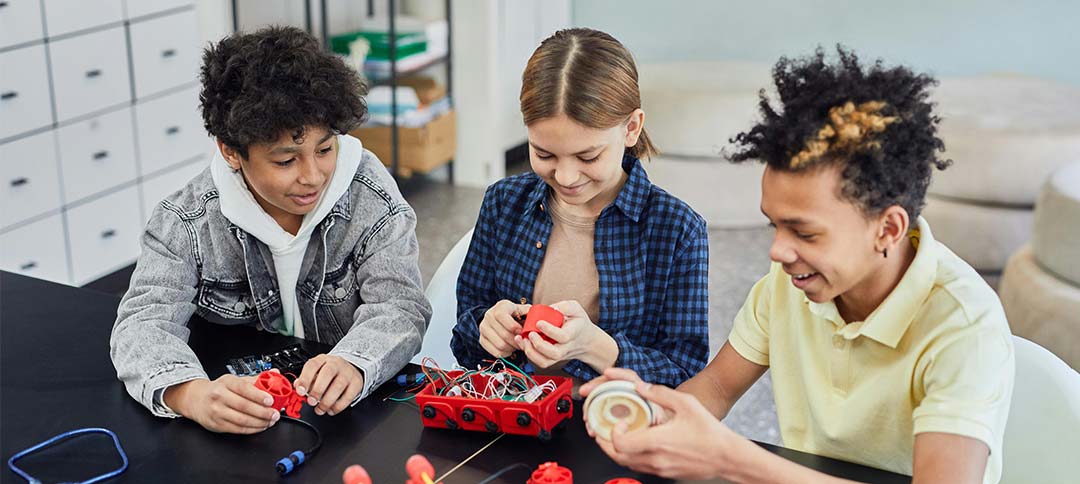You’ve probably seen the green four-leaf clover before, maybe on a t-shirt, a banner, or at a fair.
It’s part of something called 4-H, a program that’s been helping kids grow into confident, capable adults for over 100 years. But what does 4-H really mean? And what do those four H’s actually stand for?
We’re here to explain it in a simple way. No jargon. No long history lesson. Just a real conversation about how 4-H works, what kids learn, and why it matters. If you're a parent, a teacher, or someone who wants to help kids grow stronger in every way, you’re in the right place.
What is 4-H and why it matters
4-H is a youth development program that helps kids grow into strong, smart, and caring adults. It’s been around in the United States for over a century, and today, it reaches millions of young people across the country, and even around the world.
The name “4-H” comes from four simple but powerful words: Head, Heart, Hands, and Health. These aren’t just random values, they’re part of a pledge that every 4-H member learns. Each “H” stands for a different way kids learn to grow: thinking clearly, caring deeply, serving others, and living well. That’s the heart of 4-H.
The symbol of 4-H is a green four-leaf clover with a white “H” on each leaf. It represents the balance of growing minds, hearts, hands, and health together. And that clover? It’s not just for looks, it’s actually protected by law under the Smith-Lever Act, which helped create the 4-H program through the Cooperative Extension system. That’s a fancy way of saying that 4-H is supported by universities, local communities, and caring adults across the country.
If you’ve ever wondered how a simple club can turn kids into leaders, problem-solvers, and kind humans, that’s what 4-H is all about.
Breaking down each H: head, heart, hands, and health
The four H’s aren’t just words, they're a roadmap for how kids learn and grow through 4-H. Each one focuses on a part of the whole person, and together, they shape how young people think, feel, act, and care for themselves and others.
Head: clearer thinking and informed decision-making
This one’s all about learning to think things through. In 4-H, kids get to ask questions, explore ideas, and figure things out on their own. Whether they’re planting a garden, coding a robot, or running a meeting, they learn to plan ahead, solve problems, and make smart choices. It’s not about having all the answers, it’s about knowing how to find them.
Heart: greater loyalty and stronger character
4-H teaches kids to lead with kindness and empathy. They learn how to listen, how to care about others, and how to work as part of a team. It’s not just about saying the right thing, it’s about showing up, being honest, and doing the right thing even when it’s hard. This is where loyalty and trust are built.
Hands: larger service and practical action
Learning by doing is a big part of 4-H. Kids don’t just talk about ideas, they roll up their sleeves and try things for themselves. That might mean raising animals, building a birdhouse, or leading a community clean-up. With guidance from adult volunteers, they build real skills and learn how to use their hands to make a difference.
Health: better living and well-being
This H is about taking care of yourself, inside and out. 4-H encourages kids to eat well, stay active, and think about how their choices affect their future. But it’s also about mental and emotional health. Kids learn how to handle stress, support their friends, and build habits that help them stay strong in every part of life.
Each H connects to a bigger purpose: becoming a better person, one step at a time. And when you put all four together, you get the full 4-H experience, a program that grows the whole child.
How the 4-H youth development model works
4-H isn’t just one program, it’s a flexible system that meets kids where they are. Whether they live in a big city or on a rural farm, there’s a way for them to get involved. And the best part? It’s built around what they care about.
Kids can join 4-H clubs that meet in local communities, schools, after-school programs, or even online. Some clubs focus on farming or animals. Others dive into science, art, leadership, or public speaking. There are also camps, competitions, and service projects, all designed to help youth grow real-world skills while having fun.
Behind the scenes, 4-H runs through something called the Cooperative Extension system. That means it’s supported by universities and local governments, so every county in the U.S. has a 4-H office. These offices provide resources, training, and trusted adult volunteers who guide kids along the way.
Another thing that makes 4-H special is the focus on mentorship. Youth aren’t just told what to do, they’re encouraged to lead, explore, and try new things. And when they stumble (which they will), there’s always someone nearby to help them figure it out.
4-H works because it gives kids room to grow, at their own pace, in their own way, with the support they need.
The green four-leaf clover: symbolism and protection
That little green clover with the four white H’s? It’s more than just a logo. It’s a symbol of growth, unity, and purpose. Each leaf stands for one part of the 4-H pledge, Head, Heart, Hands, and Health, and together, they represent the full picture of a well-rounded young person.
The four-leaf clover is green to show life, growth, and new beginnings. You’ll see it everywhere 4-H is: on t-shirts, fair banners, award ribbons, and websites. For many kids and families, it becomes a badge of pride, something that says, “I’m part of something bigger than myself.”
But did you know the 4-H emblem is legally protected? Back in the early 1900s, Congress passed the Smith-Lever Act, which helped create the Cooperative Extension system that still runs 4-H today. Part of that law protects the clover. It can’t be used just anywhere or by anyone, because it stands for something meaningful.
So when you see that clover, know this: it represents more than just a club. It stands for a promise, to think clearly, care deeply, serve willingly, and live well. And it connects millions of young people who are growing into the leaders of tomorrow.
Why 4-H matters today: leadership, growth, and opportunity
4-H isn’t just about learning new things, it’s about becoming someone who makes a difference. In today’s world, kids face a lot. They need a space where they feel safe, seen, and supported. That’s what 4-H offers.
In 4-H, youth build leadership skills by taking real responsibility, leading meetings, managing projects, and even speaking in front of others. They gain confidence from trying things themselves and learning from both wins and mistakes. They grow stronger because they’re challenged to think bigger, work harder, and care more.
The impact doesn’t stop when the meetings end. 4-H alumni go on to become teachers, doctors, entrepreneurs, farmers, and leaders in every field you can think of. What they learned in 4-H, teamwork, grit, empathy, stays with them for life.
And 4-H isn’t one-size-fits-all. It works in small towns and big cities, with programs built for all kinds of kids, from all kinds of backgrounds. Whether it’s a robotics team in a high school, a nutrition class in a community center, or a gardening project in a neighborhood park, 4-H is there.
Because when you give kids the tools to grow, they’ll surprise you with how far they go.
How to get involved in a 4-H club near you
Joining 4-H is easier than you might think, and there’s a place for just about everyone. Whether you're a young person curious to try something new or an adult who wants to help out, 4-H makes it simple to get started.
First, every 4-H program is run locally through your county or regional extension office. That means the projects, events, and clubs are shaped by your community's needs and interests. Some focus on science or animals. Others center around public speaking, arts, cooking, or community service. There’s something for everyone.
Most kids join through a 4-H club, which meets regularly and works on group projects. But there are also school-based programs, after-school options, camps, and even short-term special interest groups if you’re not ready to commit long-term.
To get involved, all you have to do is reach out to your local 4-H office. They’ll help you find the right club, introduce you to a caring adult volunteer, and explain what to expect. In many areas, there’s little or no cost to join, and supplies or support are often available for families who need it.
Make fundraising easier
4-H is more than a youth program, it’s a launchpad for lifelong growth. Through hands-on learning, strong mentorship, and real leadership experiences, young people discover what they’re capable of. They build skills, shape character, and learn how to serve others. And they do it all while being part of a community that believes in them.
Whether you’re a parent, a volunteer, or someone looking to support youth in your area, 4-H gives you a way to make a lasting impact. Because when we invest in young people, we’re investing in the future.
At Harness, we believe in growing that kind of future. Just like 4-H supports young leaders, we help nonprofits grow with tools that make fundraising easier and more impactful. We’re proud to stand beside organizations that empower communities, one person at a time.




